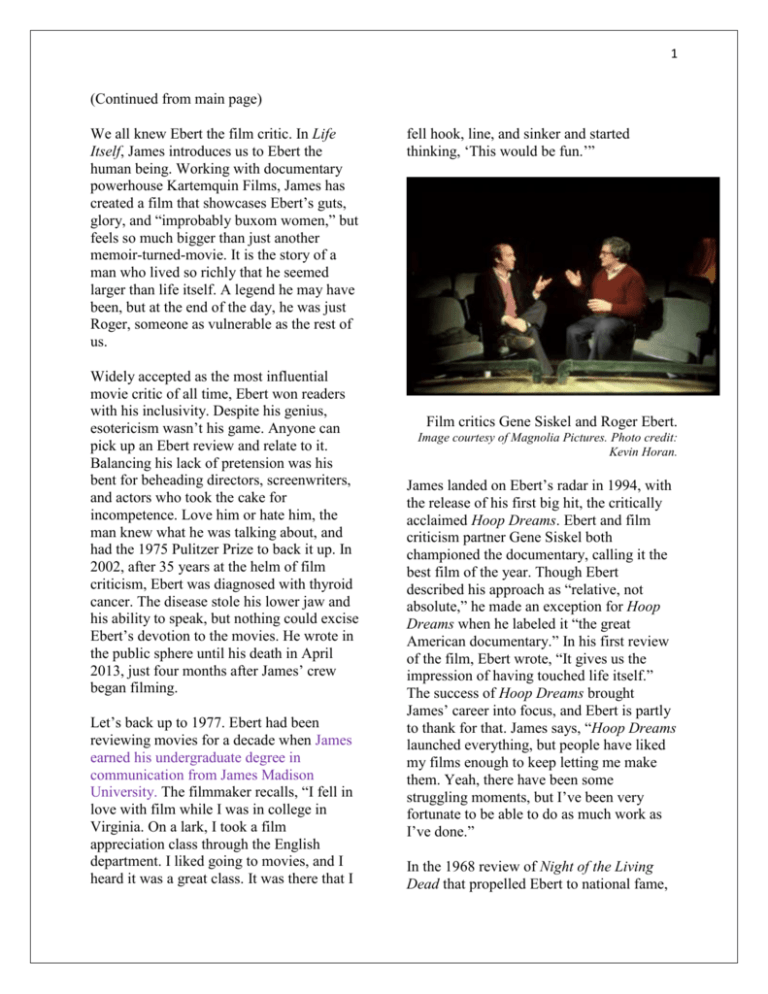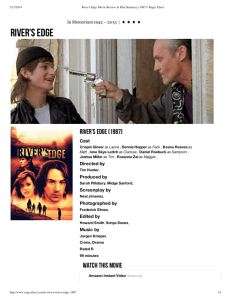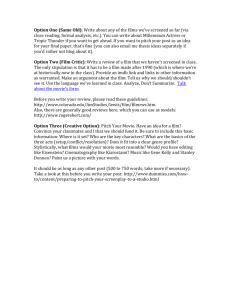Teach_Story - James Madison University
advertisement

1 (Continued from main page) We all knew Ebert the film critic. In Life Itself, James introduces us to Ebert the human being. Working with documentary powerhouse Kartemquin Films, James has created a film that showcases Ebert’s guts, glory, and “improbably buxom women,” but feels so much bigger than just another memoir-turned-movie. It is the story of a man who lived so richly that he seemed larger than life itself. A legend he may have been, but at the end of the day, he was just Roger, someone as vulnerable as the rest of us. Widely accepted as the most influential movie critic of all time, Ebert won readers with his inclusivity. Despite his genius, esotericism wasn’t his game. Anyone can pick up an Ebert review and relate to it. Balancing his lack of pretension was his bent for beheading directors, screenwriters, and actors who took the cake for incompetence. Love him or hate him, the man knew what he was talking about, and had the 1975 Pulitzer Prize to back it up. In 2002, after 35 years at the helm of film criticism, Ebert was diagnosed with thyroid cancer. The disease stole his lower jaw and his ability to speak, but nothing could excise Ebert’s devotion to the movies. He wrote in the public sphere until his death in April 2013, just four months after James’ crew began filming. Let’s back up to 1977. Ebert had been reviewing movies for a decade when James earned his undergraduate degree in communication from James Madison University. The filmmaker recalls, “I fell in love with film while I was in college in Virginia. On a lark, I took a film appreciation class through the English department. I liked going to movies, and I heard it was a great class. It was there that I fell hook, line, and sinker and started thinking, ‘This would be fun.’” Film critics Gene Siskel and Roger Ebert. Image courtesy of Magnolia Pictures. Photo credit: Kevin Horan. James landed on Ebert’s radar in 1994, with the release of his first big hit, the critically acclaimed Hoop Dreams. Ebert and film criticism partner Gene Siskel both championed the documentary, calling it the best film of the year. Though Ebert described his approach as “relative, not absolute,” he made an exception for Hoop Dreams when he labeled it “the great American documentary.” In his first review of the film, Ebert wrote, “It gives us the impression of having touched life itself.” The success of Hoop Dreams brought James’ career into focus, and Ebert is partly to thank for that. James says, “Hoop Dreams launched everything, but people have liked my films enough to keep letting me make them. Yeah, there have been some struggling moments, but I’ve been very fortunate to be able to do as much work as I’ve done.” In the 1968 review of Night of the Living Dead that propelled Ebert to national fame, 2 he wrote, “Censorship is never the answer.” It is fitting that he agreed to allow a master of the raw filmmaking style cinéma vérité to direct Life Itself. James had never before made a movie based on a book, but was ripe for the challenge. He discusses the experience: “People who have seen some of my work–and they’ve usually seen Hoop Dreams–have a certain impression of the kinds of films I make. But that’s not necessarily the case here. I liked the idea of trying to tackle a biography.” Producer Steven Zaillian (Schindler’s List, Moneyball) and his partner Garrett Basch were first to entertain the cinematization of Ebert’s book. They urged James to read the volume. “I really responded to Roger’s memoir,” says James, “It was so poignant, at times funny, and revealing. I wanted to list passages from the book so that, in essence, Roger would be the narrator of his own story. It was an exciting creative challenge to mix traditional biography with clips, archival footage, interviews, and following Roger’s life in the present the way I did.” At first, Ebert and his wife Chaz weren’t convinced that the book should be adapted to film. James recalls, “Roger was flattered that I wanted to make a film on him, but he wasn’t sure if it was really called for. There were some emails back and forth wherein I told him why I thought it was an important film to make.” Finally, after an in-person meeting with the Eberts, James was able to convey his vision to the couple. They then agreed to put all four hands on deck. James continues, “Roger knew the kinds of documentaries that he loved were honest and intimate. So he knew that if he was going to commit to this, he needed to really commit to it. There was no halfway. And once he said, ‘Let’s do it,’ he was true to that spirit.” From that time on, James and his team had exclusive access to Ebert’s final four months on earth. They shared in the heartbreak of his widow-to-be. They dabbed the tears of his beloved step-grandchildren. They witnessed as suction tubes painfully cleared his open throat of excess fluid. But they also basked in the warmth and humor that Ebert never lost. James says, “For me, one of the great lessons of Roger’s life was to embrace life fully. Life, if you’re lucky, isn’t all pain and suffering. It’s also transcendent. It’s a lot of laughs. It’s poignant and memorable moments. From being around Roger, I have this feeling that even though he had his share of suffering, heartbreak, and dark moments of doubt, he managed to embrace it all and see the value and meaning of each moment.” Roger and Chaz Ebert at their 1992 wedding. Image courtesy of Magnolia Pictures. Ebert was 50 and halfway through his career by the time he married the greatest love of his life, Chaz. James says, “Chaz was even more than Roger’s life partner and his protector and motivator through illness. She was also involved in the business aspect of his life. Once Roger made the decision to do the movie, then she wanted to help make it a reality. But she also respected the boundaries that she could not have editorial control of anything, and that I had to be able to make the film that I was going to make. We could never in a million years have pulled this off without her constant support.” 3 In designing an authentic and absorbing account of Ebert’s life, James has once again shown that he is, above all, a storyteller. He says, “I feel that at heart, my films are stories about real people that hopefully draw you into their lives in an intimate way. So there are larger issues that a film may address, for example, violence in my 2011 documentary The Interrupters, but the way we get to the point is through the lives of people. I’m always looking to suck the audience into the story through people who are amazing or interesting or provocative. For me, that’s the key to maintaining audience interest. I don’t generally interview experts because, in my films, the people that are living it are the experts. These are choices that other filmmakers might not necessarily make.” Martin Scorsese, an executive producer of Life Itself, is on set with director Steve James and producer Zack Piper. Image courtesy of Magnolia Pictures. Like many great storytellers, James doesn’t always begin a story knowing how it will end. He says, “Going into making a movie, you have to have a strong idea about what you’re hoping to accomplish and why. Without that, you’re rudderless. And you won’t get funding either, no matter who you are or what else you’ve done. Once you make it through the planning phase, then the fun really starts. That’s when you get to go out and make it. You get all these wonderful surprises and unexpected twists. You learn that people aren’t what you thought they were. Or you meet new people who are more interesting than the person you initially intended to follow. All of those things are what make this worth doing. The act of discovery that comes with going out and actually doing the film and remaining open to where it wants to take you.” James reveals the most profound twist of Life Itself: “When we started, we had no idea that Roger would not be with us four months later. It makes the film, among other things, also a film about dying. How you die, and how you do it with great grace and dignity. Roger made death feel like something not to be feared. Of course, none of us knows what happens until we get there.” Chaz Ebert posted on her blog on the oneyear anniversary of her husband’s death: “What […] I’m most grateful for in this year since my beloved husband left us is that I have no regrets.” James feels the same way about his film. He says, “There are a million things that would have been great to put in the movie. Roger would tell these long, entertaining bar stories. You’re not really sure how true they are, but it doesn’t matter because it’s a great story!” James chuckles. “That’s the problem with every movie; you can’t put it all in. You have to make some hard decisions. But it’s when you’re throwing out the good stuff that you feel good about what you’re making. Hopefully, that means you’re leaving in the better stuff.” 4 Now that Life Itself has been completed, James has other projects on the horizon. For the past two years, he has been dedicating energy to the Generation Food Project, a collaboration that takes a global look at how people feed themselves in the 21st century. James and the Generation Food team aim to make a documentary, book, and multimedia project surrounding the issue. Of course, this project overlapped the making of Life Itself. James says, “I always try to work my chedule so I can devote myself to the one film that’s front and center. I’m just a much better filmmaker that way. ” Life Itself theatrical release poster. Image courtesy of Kartemquin Films. The word filmmaker fits James in every aspect of its meaning. Most directors of his caliber do not perform the time-consuming task of editing their own films. But it’s not unusual to find James sitting alone at a computer, cutting a movie together. Regardless of whether other successful filmmakers are editing, James doesn’t seem bothered. He says, “In the editing stage, I am truly living and breathing a film. When I’m editing, I’m thinking about it. When I’m not editing it, I’m thinking about it, and I’m even dreaming about it. I love that part of the process, because when you’re completely immersed in a film is when it really has the potential to get good.” James can also be spotted with a camera on his shoulder, though he says the amount of time he spends shooting depends on the film. He explains, “That moment in Life Itself when Roger says, ‘Shoot yourself in the mirror, Steve’ may be a little misleading. For this film, I shot a fair amount of the hospital stuff due to the intimacy factor. But for something like The Interrupters, I ended up shooting the whole film because we had to be able to run out at a moment’s notice to film our subjects.” But by the end of each project, James has somehow turned thousands of hours of grueling research into an easy watch. James has poured an enormous amount of work into Life Itself; now it’s time to break out the cigars and present the new baby to the world. Kartemquin Films’ Director of Communications and Distribution Tim Horsburgh says, “I continue to be amazed by just how much enthusiasm there is for the film, and how beloved Ebert is. We had people crying at the trailer, so many requests for screenings, and the social media buzz has been nonstop. It’s truly exciting to be in the middle of the community that has already formed around this documentary.” The film will be released on July 4, 2014 in theaters and On Demand, but was presented earlier at this year’s Nantucket Film Festival. Life Itself was shown at the Dreamland Theater on Friday, June 27 and Sunday, June 29. ● This article appeared in Yesterday’s Island, Today’s Nantucket at http://yesterdaysisland.com/capturing-life/





